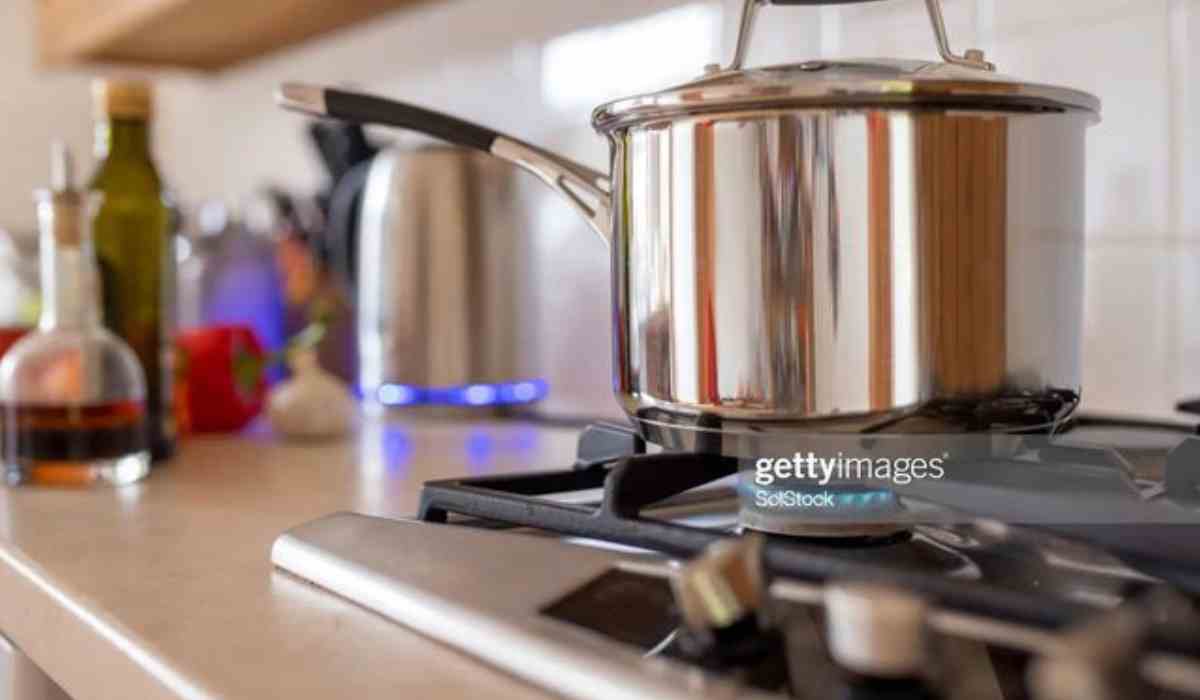A grimy gas stove presents more dangers than one might realise. Apart from being unsanitary, a burner clogged with food residues leads to weak flames and uneven heat distribution, which can damage cookware, give inaccurate temperature control and pose a fire hazard. Regular cleaning of your gas stove is essential to mitigate these risks.
See also: Importance of kitchen cleaning and how to do it perfectly
What do you need to clean a gas stove?
Before embarking on cleaning the gas stove, keep the following supplies ready:
- Mild dish soap
- Baking soda
- Vinegar
- Medium-stiffness scrub brush
- A soft, dry cloth
- An old toothbrush
- Non-abrasive scrub pad
Steps to clean a gas stove at home
Step 1: Ensure safety
Before you start cleaning your gas appliance, ensure that all surfaces are completely cool and the control knobs are turned to the off position. It is crucial to prevent accidental gas flow while removing burner guards and scrubbing knobs.
Step 2: Disassemble the stove
Remove the grates and burner caps as per the instructions provided in the stove’s manual. Typically, these components can be simply lifted off for cleaning.
Step 3: Clean gas stove pan supports
Lift the trivets and wash them in warm, soapy water with a non-abrasive cloth or sponge. For stubborn stains, use a stove cleaner or a non-metallic brush. Alternatively, soak the pan supports in warm soapy water for 20 minutes. Since these trivets are made of cast iron, dry them immediately after washing to prevent rust. Use a soft cloth to wipe them dry. Once cleaned and dried, carefully place them back. You can briefly turn on the heat for a few seconds to ensure they are completely dry before use.
Step 4: Clean the burners
Burner caps and heads should be washed with a small cloth or an unused toothbrush. For stubborn burnt-on spills, soak them in warm, soapy water to soften the soil. It is important to clean spills with high sugar or acid content immediately to prevent dull spots. For extra stubborn marks, a paste of baking soda and water can be effective. To ensure uninterrupted cooking, clean the spark plug and flame safety device with a moist cloth. After cleaning, make sure the burners are completely dry before reassembling them. This helps prevent clogs and ensures the safe and efficient operation of your gas stove.
Step 5: Clean the stove top surface
The cleaning method depends on the surface material.
- Stainless steel surfaces: Stainless steel requires special care to maintain its finish and durability. Spot test or refer to your gas stove’s user manual for guidance. A speciality stainless steel cleaner dissolves grease and restores shine. Alternatively, you can use warm soapy water, rinse thoroughly and buff dry with a microfiber cloth. To prevent stains and streaks, wipe in the direction of the grain, ensure thorough buffing to avoid air drying and avoid abrasive or acidic cleaners.
- Ceramic or glass surfaces: Gentleness is crucial to prevent micro-scratches on glass or ceramic surfaces. Use a glass cleaning spray or cream formulated for stoves. Apply the cleaner to the surface and wipe gently with a microfiber cloth in a circular motion. Buff the surface dry to avoid streaks. For stubborn burnt-on residue, a ceramic scraper can be used carefully.
Why should you clean your gas stove?
- Even flame distribution: Clogged burners can disrupt the gas flow, resulting in uneven flames. This can be hazardous, causing pots to tip over or creating hot spots that may lead to burns.
- Efficient cooking: Clean burners allow for optimal gas flow, producing a stronger and more consistent flame. This enhances cooking efficiency by providing precise heat control.
- Proper ignition: Accumulated grease and grime around the igniters can hinder proper sparking, making it challenging to ignite the stove consistently.
- Avoid wasted gas: Clogged burners necessitate higher flame settings to achieve desired heat levels, leading to unnecessary gas consumption and increased utility costs.
- Prevent lingering odours: Residue and burnt food particles on grates and burner caps can emit persisting unpleasant odours, which regular cleaning can prevent.
- Aesthetics and hygiene: A dirty stove with greasy grates looks unappealing and serves as a potential breeding ground for bacteria. Regular cleaning maintains the stove’s appearance and reduces the risk of contamination.
Useful tips for cleaning a gas stove
- Use ammonia for deep cleaning: For stubborn stains, especially on burner caps and grates, use ammonia. Ensure proper ventilation during use to avoid skin and eye contact.
- Clean regularly: Prevent grease and grime buildup by cleaning your gas stovetop regularly. A quick wipe-down after each use can make a significant difference in maintaining cleanliness.
- Avoid abrasive cleaners: Refrain from using abrasive cleaners or scouring pads on your stovetop as they can scratch the surface, damaging its appearance.
- Cool down before cleaning: Never clean your stovetop with water while it is hot as this can cause the surface to crack. Wait until it has cooled down sufficiently.
- Use warm water and dish soap: For everyday cleaning of minor spills and grease splatters, a simple solution of warm water and dish soap works wonders. Apply with a damp cloth, wipe clean and dry with a soft microfiber cloth to prevent streaks.
- Baking soda for tougher stains: Create a paste with baking soda and water to tackle tougher grease and grime. Apply the paste to the stained areas, let it sit for 15-20 minutes to loosen the grime and wipe away with a damp cloth. Rinse the surface with clean water and dry thoroughly with a microfiber cloth.
- White vinegar for burnt-on stains: Mix equal parts of white vinegar and water in a spray bottle. Spray the solution on stubborn burnt-on stains, let it sit for a few minutes and scrub with a damp cloth to remove the stains effectively.
How often should you clean your gas stove?
The frequency of cleaning depends on your usage. Regular cleaning, especially after each use, prevents food particle accumulation and stubborn stains. Maintaining a clean stove can extend the lifespan of your gas stove. Even if you use your stove less frequently, wipe it down after each use. Whenever you notice spills or stains, clean your gas stovetop promptly. However, regardless of cooking habits, it is advisable to perform a monthly deep cleaning of your stovetop, including grates and burners.
How to keep your gas stove clean?
- Wipe up spills immediately: Do not allow spills to sit and harden. Use a damp cloth to wipe them up as soon as you finish cooking.
- Daily wipe-down: After each use, wipe down the entire stovetop with a damp microfiber cloth. This quick cleanup will remove grease splatters and food debris before they can solidify.
- Schedule a weekly cleaning session: Allocate time each week for a thorough cleaning. Remove the grates and burner caps to soak and scrub them. Clean the cooktop surface with vinegar, baking soda or a suitable commercial cleaner.
- Use pot lids: Whenever feasible, use pot lids to contain splatters and prevent grease from escaping. This significantly reduces the amount of cleaning needed for the stovetop.
- Low and slow cooking: Avoid using excessively high heat settings as they can lead to more splattering and burning. Opt for lower heat levels and simmer whenever possible.
- Line your oven with a drip pan: Place a drip pan on the bottom rack of your oven to catch any drips or spills that might overflow from pots during cooking. This prevents them from dripping down onto the stovetop below.
- Keep baking soda handy: Baking soda is a versatile natural cleaner and safe to use on most stovetops. Keep a box of baking soda within reach for quickly cleaning minor spills or grease splatters.
Housing.com POV
Maintaining a clean gas stove is not about appearances; it is essential for safety, efficiency and longevity. A grimy stove harbours bacteria and hampers cooking performance, posing risks like uneven heating and potential fire hazards. Regular cleaning can effectively remove stubborn stains and grease buildup. With daily wipe-downs and weekly deep-cleans, you ensure your stove operates at its best, with even flame distribution and proper ignition. This enhances cooking precision and extends the lifespan of your appliance.
FAQs
Why should I clean my gas stove regularly?
Regular cleaning of your gas stove ensures even flame distribution by preventing clogged burner holes, which can lead to uneven cooking and potential safety hazards. It maintains proper ignition by keeping igniters grease- and grime-free. Regular cleaning prevents gas wastage due to inefficient burning and reduces the risk of lingering odours and bacteria buildup.
What should I use to clean my stainless steel gas stove?
Stainless steel gas stoves require special care. You can safely clean stainless steel surfaces with warm soapy water and a soft cloth. For tougher stains or grease buildup, use a stainless steel cleaner specifically formulated for kitchen appliances. Always wipe in the direction of the grain to prevent scratching and ensure thorough drying with a microfiber cloth to avoid water spots and streaks.
Can I use abrasive cleaners or scouring pads on my gas stove?
Avoid abrasive cleaners or scouring pads, especially on a glass or ceramic surface. Abrasive materials can scratch the surface, damaging its appearance and making it susceptible to stains. Opt for non-abrasive cleaning solutions, like baking soda paste or vinegar diluted with water, for effective yet gentle cleaning.
How often should I deep-clean my gas stove?
The frequency of deep cleaning depends on your usage. For frequent cooks or busy kitchens, monthly deep-cleaning of stoves, grates and burners is advisable. This removes stubborn grease and ensures optimal performance. Performing daily wipe-downs after each use can prevent food particles from hardening and becoming challenging to clean later.
What is the best way to prevent stains and grease buildup on my gas stove?
To prevent stains and grease buildup on your gas stove, wipe up spills immediately after cooking. Use pot lids whenever possible to contain splatters. Avoid using excessively high heat settings as this can lead to more splattering and burning. Incorporate a weekly cleaning routine that includes soaking and scrubbing grates and burner caps to maintain a clean and hygienic cooking environment.
| Got any questions or point of view on our article? We would love to hear from you. Write to our Editor-in-Chief Jhumur Ghosh at jhumur.ghosh1@housing.com |







